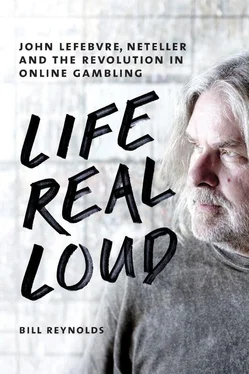We walk into the wine shop on Fourteenth. Same pattern. The lady drops everything and attends to Lefebvre, who introduces me, again, as his writer friend from Toronto. The proprietress knows exactly what kind of wine Lefebvre likes: full-bodied, expensive reds. “The one thing I know is that good wine doesn’t give you a hangover,” he’s told me more than once. I believe it, of course, but Louise, his mom, being the one remaining devout Catholic in the family of Catholics, cannot understand the need for high-end wine. “Nobody needs to buy wine that expensive,” she’ll say. “I wish he would just give all of his money away to poor people.”
Her son has given away an awfully big chunk of his money — to the poor, to single moms ignored by banks who need mortgage financing, to shelter kids for football tickets. The scroll of good deeds would hit the floor and roll a country mile, along with the monster commitment to environmental projects. But you know what, Mom, the wine habit stays.
We sample a just-uncorked sixty-buck red. I’m no expert, but immediately I’m convinced the liquid is a marvel that would make wine critic Robert Parker swoon and jot down ninety-three. Various flavors burst onto the tongue, although not in the shrill way of, say, a jazzed-up South African or Australian shiraz; no, they seep into the palate with subtlety and complexity. I try to resist the temptation to down the sizeable sample; it is so good I want to chug it till it’s drained. But I resist, sloshing the ruby liquid around in the large bowl of the glass, using what may or may not be the proper method — holding the base of the glass, keeping the base on the table surface, rotating it in a clockwise then counterclockwise motion to move the liquid around, freeing up its aroma and then judging the lasting nature of the legs it leaves behind on the glass upon returning to rest — before putting more of the silky taste to my lips.
Lefebvre likes the wine. He likes the lady who serves the wine. He likes the fact that she saves him some trouble by hand-picking a white wine for him, just in case. He says he doesn’t need to sample it. “Sure, I’ll take a case or two.” He trusts her judgment. Truth is, he doesn’t much care for white. His plastic injects the lady’s business with just under ten grand. We walk out. The wine place delivers, too.
We head over to the Paul Kuhn Gallery on Eleventh Avenue SW. Lefebvre hasn’t been in for a while. The attractive, lithe, young woman is in a mood to sell. She entices Lefebvre with some art. She says what’s on the walls is all gone except for two. But look at what’s left, aren’t they both gorgeous? Lefebvre instead focuses on one that has a red dot on the little white card. “I’m sorry, John, that one’s gone.” She tries to distract him by turning his attention back to one unsold piece featuring a nude female immersed in an abstract landscape. She sways him. He looks at the painting. Her bet is on Lefebvre’s love of the female form. “Yeah, maybe.” He appreciates her effort, but he’s not really that interested in buying anything more today. He’s just dropped nearly twenty grand on flatware and wine, for one thing, although I suspect he might have given in if the sales job had been more convincing.
Lefebvre likes to hear the pitches. He’ll buy just about anything if it’s pitched the right way. He likes the fact that he can travel among the merchant class and be noticed and treated with respect and that he can return the favor by dropping buckets of cash to support them. It’s like the king walking among the commoners at a feudal market, spreading around the wealth and good cheer.
But this afternoon the king is interested in picking up a work that’s been with the framer’s shop in the basement for quite some time. “John, we haven’t seen you! I was just thinking about you, wondering when you were going to come around and get your piece.” Lefebvre does walk out with his purchase under his arm this time, and we delicately negotiate the large canvas into the back of his SUV. That’s enough for one day. Maybe tomorrow there will be more purchases to be made for the wedding.
* * *
The next day at 9:30 we gas up and head out to Springbank, Alberta, on a sunny, cool, perfect Western fall morning. It’s hangin’ at the hangar time on Hurricane Drive. We leave Calgary behind as we motor along the Trans-Canada Highway. Springbank is a barely rural community of residential acreages—“barely” in the sense that the city of Calgary has gobbled up annexed land, parceling it into subdivisions with names like Strathcona, Prominence Park, and West Springs. The city is advancing westward, moving closer.
Lefebvre keeps many of his motor toys out here at Springbank Airport. Dale Kirkwood, the pilot, hangs out here, too. He owned his own Ford Mustang in high school, and now his son Justin has his own kiddie drag racer stored in the hangar. It’s fuel-injected and is equipped with a lawnmower motor. Justin is also allowed to use the pool table on the second floor. Once the door is unlocked, we come inside to a whole other level of man-cave, one large room with a high ceiling and the usual industrial metal upper supports exposed. There is a lot of eye candy: two jets, several classic cars, and one vintage motorcycle. A flight of stairs at one end leads to an office where the flight logs are stored. That’s also where you shoot pool. Lefebvre’s business jet is a 1982 Cessna Citation II (Model 550). Immediately, he recalls the interest in his flying habits:
Did I tell you about the meetings with the DOJ? They asked, “What does Dale do when he’s not working for you?” I said, “Dale’s never not working for me. Dale works for me — that’s all.”
“Really? Where does he go with your plane?”
“He doesn’t go anywhere with my plane, unless I’m on it or unless one of my guests is on it.”
“Really? It seems like he’s flitting around.”
“Oh, he went to Phoenix to look for a car for me, and he went to Ohio to buy another car. Actually, he went to Brazil and bought a jet. He went three times. Actually, he went four times, because the first time he bought a jet for this other guy. But the last three he bought a jet for himself. He had some trouble getting it back up here. I financed the jet, he owns it — it’s his retirement package. They stopped him at the border because he had a picture on the floor and a film on his cell phone of me shooting my potato cannon. He goes, ‘Artillery? There’s no one shooting artillery. That’s my boss, that’s a potato cannon.’ And they said, ‘Why would you want to shoot potatoes?’”
Lefebvre’s plane was appraised at $2.4 million. He paid $1.4 million and then spent $600,000 putting new engines on it. He bought the hanger for $400,000. That was before the recession hit. Now he’s talking about getting another businessman to share the cost of the hangar, the jet, and Kirkwood’s time. That kind of partnership talk pains him, not just because of the inevitable situation that would crop up where both owners want to fly at the same time: “It’s like a fucking marriage. I hate that.”
Upstairs, Lefebvre stores some of his plane’s seats. The Citation II is built for eight passengers plus the pilot, but it’s more comfortable with four or five. It’s a little larger than average, having six windows instead of the usual three. Its ground speed is 395 miles per hour, about ninety miles per hour slower than commercial traffic. Its altitude ceiling is 43,000 feet, but Kirkwood flies it at around 35,000. The cost of burning fuel to get to the upper limit outweighs the advantages of less wind resistance and engines tuned to work best in thinner air. Not that they haven’t tried it on long-haul trips. “It’s neat, the difference,” Lefebvre says. “At thirty-five it looks like the earth is flat; at forty-three it looks like the earth is round. You start to see the curvature.”
Читать дальше












